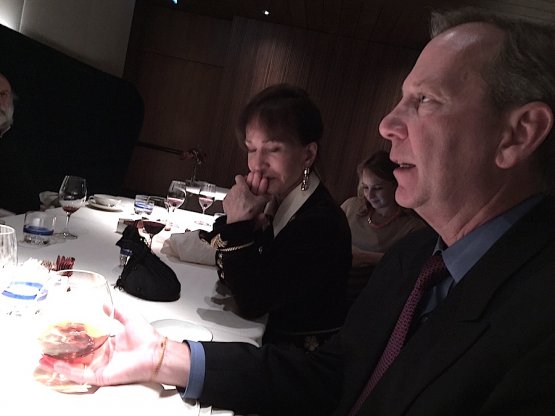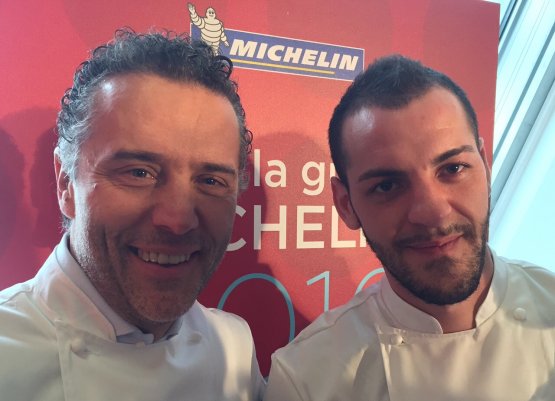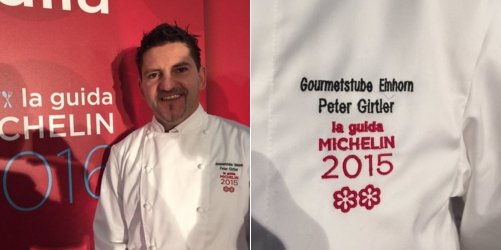Right after the presentation of the Guida Michelin Italia 2016 (we reported about it yesterday, in the spur of the moment), we are led to the Michelin offices in Pero, a 3 minutes’ drive from the Mercedes headquarters, where the starred chefs received their prize. We meet Sergio Lovrinovich, the editor in chief whose face is unknown, this year on his third mandate from the Red Guide. It had already happened last year, this year he granted us an exclusive interview. All this before we later found out about Mattias Peri, patron-chef in Livigno who passed away in August and is still in the guide and with a star too.
Lovrinovich appears to be very willing to comment on promotions and failures. A proof of the desire to change attitude that is more and more evident and in contrast with the unbridled cryptic approach of the past. What follows is the result of a friendly chat between three people lasting one hour more or less.
The news that caused the bigger clamour this year is a bad one. Combal.zero was downgraded from 2 to 1 star. What was the reason?
I can tell you that we have a very substantial dossier on the matter, the result of various dining tests. It’s a case we’ve followed for over a year, as with all the restaurants with 2 or 3 stars, doing well or doing poorly.
Is it a matter of food or has it to do with other aspects?
Stars are always and only food-related. Technically speaking, however, I’d rather tell Davide Scabin first, the reason of this downgrading, provided that he wants to know it. If we notice some défaillance in the cooking, we tell the chef only if he asks us: we don’t work as consultants but we’re attentive to our readers. We spontaneously warn the patron only in the case of very bad problems in the service.

Michael Ellis, international director of the Michelin Guides, sipping his beloved Fernet Branca on Tuesday night at Seta. "If we’re awarding street food restaurants in Asia, it’s about time we start looking at pizzerias in Italy in a different way". According to Sergio Lovrinovich, editor in chief at Michelin Italia, "It’s hard to award a pizzeria because contrary to ‘normal’ dishes, leavening depends on a thousand variables"
is a very simple place with superb products. A pizzeria as such doesn’t meet our standards. But this doesn’t mean it cannot change, if we were to find a pizzeria making 10 extraordinary pizzas, we’d award it right away.
Was this not the case this year?
No, one of the clear problems is that keeping the same quality standards with a dish is easier than with pizza. The latter depends on factors that can vary greatly, such as the oven’s temperature or the leavening, which can change a lot depending on the humidity of the rooms, even from one day to the other. We can notice the same with bread: in many starred restaurants you can have under par bread because there are too many variables in play. I remember once, at
Maxi in Capo La Gala, with the consultancy of
Oliver Glowig, I was wondering where the famous
zeppole were. They told me they couldn’t make them that day because of the exceeding humidity.
Among the restaurants that didn’t get a star, two struck us in particular: Leone Felice in Erbusco and Trattoria Zappatori in Pinerolo.
We’re keeping an eye on Leone Felice: the chef has a good cv. We’ve been there more than once: they’re good and committed.
Christian Milone is another dossier we had…
The results for Milan were not elating: 3 promotions (Armani, Seta and Tokuyoshi) and 2 failures (Al Pont de Ferr and Trussardi alla Scala). Is there a particular idea behind this?
No, we don’t follow an editorial policy when giving Stars. We are always looking for interesting food, without preconceptions or urban trends.
What happened to Pont de Ferr?
It’s a place I knew very well because I lived in the Navigli area in Milan for a long time. When chefs change [from
Matias Perdomo to
Vittorio Fusari]
sometimes it works, sometimes it doesn’t, as in this case.

Giancarlo Perbellini’s stars (in the photo, to the left) are in fact 3: 2 for Casa Perbellini in Verona, but also one new star for Dopolavoro in Venice (to the right, executive chef Federico Bellucco)
This doesn’t happen that seldom: it happened with the
Forte Village restaurant in Sardinia in the past. At
La Gallina there’s been a sudden drop in quality. It can happen if a restaurant perhaps changes 2 or 3 people in the kitchen and isn’t capable of keeping the standards of the previous year... The chef’s strength is also based on the fact he can count on efficient people in the kitchen.
Agostino Buillas at
Cafè Quinson, who works excellently and almost by himself, is a very rare case.
Out of curiosity: how long in advance do you alert a chef of a star?
Usually, one week or ten days before the presentation. But this year we’ve called some people even only one day before. As with
Andrea Cannalire of
Cielo in Ostuni. He couldn’t come because he was on honeymoon. Even
Thomas Ebner of
Dolce Vita Stube in Naturno, a guy who only speaks English and German, couldn’t come. He sent his sous-chef to represent him but the jacket bears the signature of the chef, we couldn’t have his second wearing it.
As with all paper guides, when they’re out, some of the info is out-of-date.
Indeed, it’s the limit of paper: this year we completed all content on the third week of September. In the meantime, we know
Antica Osteria del Teatro in Piacenza closed, which they didn’t tell us,
All’Oro in Rome has closed because they’re moving,
Locanda del Pilone in Alba changed chef,
Cecchini in Friuli closed and will open again with a new format,
Palazzo Petrucci in Naples has an uncertain future ahead …
Last year you explained to us there were more than a restaurant close to 3 stars. Out of the 38 two-stars of today, which were the ones closest to 3?
All of them. In theory, it is possible to move from one to three stars in one fell swoop. And I wouldn’t exclude that even a restaurant that has had 2 stars for 15 years, as with
Da Caino in Maremma, perhaps with the introduction of young people bringing fresh lymph, could finally get the third one. But perhaps you at
Identità Golose know more about the evolutions taking place in the kitchen. We visit, describe in detail, pay and leave.
Let’s get to the positive elements. What regions struck you the most this year?
Campania has improved a lot, and not just for the 3 new starred restaurants –
Don Geppi,
Re Maurì and
Osteria Arbustico. I was particularly impressed by
Cristian Torsiello’s cooking in Valva: he’s a very determined young man, with a great talent in enhancing a secluded territory and socially difficult areas, just like
Luca Abbruzzino in Catanzaro, whom we awarded last year. Yet the chefs from Campania work export their talents too, as with the chefs at
Magnolia in Forte dei Marmi or at
Vespasia in Umbria. And, always referring to Campania, I’d like to remind you that last year
Giuseppe Mancino of
Piccolo Principe in Viareggio lost two stars.

Peter Girtler, chef at restaurant Gourmetstube Einhorn inside hotel Stafler in Vipiteno in Alto Adige, 2 brand new Michelin stars
in the previous restaurant in Isola Rizza and now in this new one. He has drastically changed his cooking. I found a thrilling, phenomenal tasting menu.
Girtler is one of the many chefs from Alto Adige who offers excellent cuisine because it is sound. We’ve noticed
Peter has improved in the kitchen, the result of an impressively detailed work. In a secluded, pure, beautiful area.
What are you favourite dishes this year?
A ricotta dessert made by
Torsiello: never had such a delicious dessert. Then
Perbellini’s
Scampi with hazelnut cream, idyllic. While
Girtler’s foie gras looks like a painting, technically perfect. A dish based on the balance of many ingredients, like those made in the Basque Country or in certain areas of Spain.
Have you got an ideal menu?
I make no distinction between meat and fish. I’m a glutton.
No idiosyncrasies?
During my job interview, I said I don’t love brain too much, but when it’s fried well, it’s amazing.
Do you prefer risotto or pasta?
Risotto, but you need to make it properly.